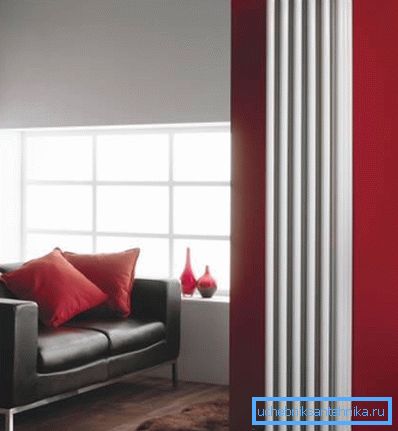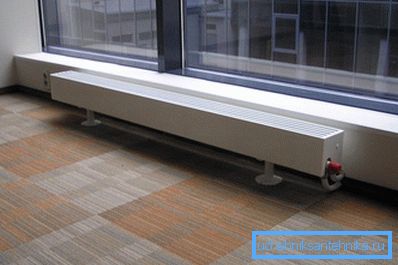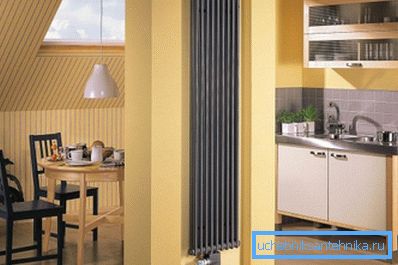Narrow radiators: variations and uses, horizontal and
The choice of heating radiators is usually associated with the calculation of heat output and heat losses, however, there remains one more important point - the device’s compliance with the room design. Standard batteries are far from always relevant, and we want to consider narrow horizontal radiators, vertical models and the features of their operation.

Narrow radiators
Species

The definition of “narrow” seems to be quite streamlined and vague, therefore it is necessary to introduce some clarity.
Let's start with the fact that narrow can be called not only horizontal but also vertical projection of the product, thus, we get two groups:
- Narrow horizontal devices, whose height is much less than the width, that is, the horizontal projection of the case is considered;
- Vertical devices, whose width is much less than the height, and the object of consideration is the vertical projection of the body.
Note! Vertical and horizontal batteries are used in different ways and solve various technical and design tasks.

This group of convectors can be subdivided on the basis of the generally accepted classification, so we can safely distinguish the following types:
- Tubular registers, made of steel, copper or cast iron. The design is a system of vertical or horizontal tubes connected by headers, it is very popular in a narrow design;
- Sectional Cast Iron Batteries. This is a habitual model for residents of post-Soviet cities, which is also very popular in the production of non-standard products;
- Sectional convectors with fins. These are modern aluminum or bimetallic devices with characteristic vertical plates;
- Steel panels. Represent the welded profile steel plates which form internal channels due to profiling. Coolant circulates through the channels and heats the panel.
Note! Each type of construction has its pros and cons, therefore, when designing a heating system with your own hands, it is better to read separate articles on our website devoted to types of radiators.

Among other things, narrow convectors can be made of various materials. The material used also greatly affects the efficiency of the device, so this factor should be taken into account.
Today batteries are produced from such metals:
- Cast iron;
- Steel;
- Aluminum;
- Copper;
- Steel + Aluminum;
- Copper + aluminum.
The highest heat transfer is observed in copper and aluminum products, but the former are too expensive, and the latter are demanding on the coolant and pressure in the system. Steel appliances are afraid of water hammer and corrosion, cast iron - too heavy and inert.
A bimetallic steel-aluminum radiator is considered a compromise solution.

Note! The classification and differences of the types of devices do not depend on their sizes and are made according to the general rules.
Purpose

Let's talk about the appointment of narrow heating devices. Why are they needed?
The fact is that it is far from always possible to successfully fit standard products into the interior, especially in modern apartments and houses. It is known that it is customary to install radiators under the windows, but current trends tend to increase window openings, and conventional batteries simply do not fit on the window sill.
Often the window occupies the entire height of the wall. In this case, underground convectors are mounted, or a high and narrow radiator is installed near the window, which solves the problem of heating a given area of the house.

Often there are homes with a non-standard design layout, which does not imply the usual placement of batteries. In this case, the heaters can be installed in special niches, on the walls or in the corners.
The rooms of bathrooms and toilets, as well as kitchens and hallways often have unusual shapes and sizes. It also proves appropriate to use convectors with narrowed dimensions.
Finally, it often happens that the device of an unusual shape becomes an accessory and decorates the room, forms its style and creates a certain atmosphere. In this case, its use is purely artistic in nature.

Note! The use of narrowed radiators is due to the fact that standard appliances do not fit or fit poorly in the interior, as well as due to the designer’s delights. As a rule, both causes play a role.
Horizontal convectors

Horizontal models are common much wider vertical. This is due to objective reasons: modern windows have become taller and larger, and heaters of usual sizes can no longer be placed under them. The dimensions of narrow radiators are 150, 200, 250 and 300 mm.
In addition, the work of a low convector is much more efficient, since the coldest air is concentrated below, therefore, the heat transfer is more active. Although, if we compare the efficiency with a standard device, the low heater loses.

Low horizontal models are most often two or three tubes with vertical fins. Most of the energy is transmitted through direct heat transfer and convection.
Also found are cast iron sectional varieties, panels and batteries of tubular sections with aluminum fins. Plinth and underground models should be referred to a separate group, as they differ greatly in the rules of connection, strapping and installation.

Note! Horizontal low devices do not have significant differences in connection and installation, except for models with concealed installation.
Vertical batteries

Models with a vertical orientation are much less common, and most often available in stores only on order. This is due to the fact that such products are used mainly to create unusual interiors.
From a technical point of view, the vertical orientation is unprofitable, since the top is heated air, which reduces the intensity of heat transfer. Convection activity also decreases, warm masses accumulate under the ceiling.

The artistic value of batteries with a vertical installation does not cause doubts to anyone: they often cannot do without them, especially in rooms with columns, high windows on the entire wall, a large number of openings and niches in the walls.
However, such interiors are found only in rich homes, so the price of vertical models is high, and popularity among the masses is low.

Note! Vertically oriented heaters often solve purely artistic problems and are not widely distributed.
Conclusion
Heating devices with a narrowed profile are widely used in areas with a non-standard design or larger windows. To experience the specifics of using such products, see the video in this article.